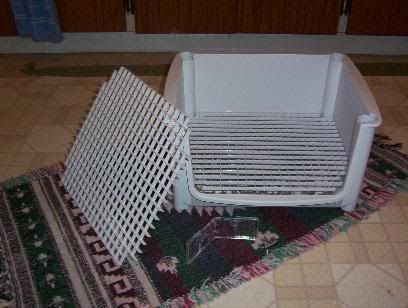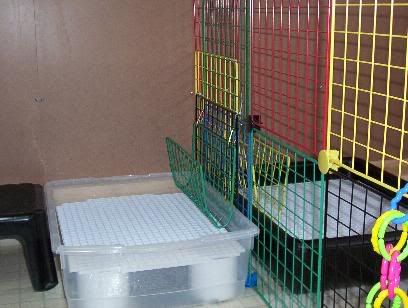The picture to the right shows the setup that I used back when my rabbits were still young and unbonded. The main compartment is a kitchen organizer that I purchased at Zellers... perfect size for a small single bun. The high back and sides help to prevent your bunny from urinating over the edges of the box. The white plastic grid which we use in our application as a false bottom floor is called "eggcrate", and is manufactured for use in flourescent drop ceilings. You can purchase eggcrate at the Home Depot, and then cut it to fit your litterbox using heavy duty cutters. The eggcrate sits on top of several PVC tubes (cut to length) to create a false bottom. The waste will then fall through the plastic grid, into the space below. This is more sanitary compared to traditional setups (as the bunny is not sitting in his own waste). This also decreases the chance of him aquiring Coccidoisis. This is a rabbit disease of the liver and/or intestinal tract that your rabbit can contract if he consumes food (incl. hay) that has been contaminated with feces from an already infected rabbit. Prior to my happy discovery of PVC tubing I used a variety of object including clear plastic picture frames (pictured above), which worked pretty well, but not prefectly as they did have a tendancy to tip over. Once the litterpan has been in use for a few days (1-4ish depending on size of box) you then just remove all waste and used litter to the garbage, and soak the litterpan pieces in a solution of 1/10 bleach and water. Now that I have a bonded pair, and do best with a large size litterbox I use a larger version of the box shown to the left. Hopefully you can see that I have a hay rack attached over the litterpan. It was made by bending, into a "U" shape, one panel of an NIC (Neat Idea Cube) kit. NIC panels can be purchased from places like; Wal-Mart, Costco, Zellers, and the like. I love this version of a hay hopper because it holds large amounts of hay, and allows for easy access by the bunnies. By providing hay in conjunction with the litterbox you help to ensure that your bunny will deposit all their eliminations in the appropriate place. It works well because it is quite natural for a rabbit to eat and eliminate at the same time. If you experiment with different sized boxes and objects to create the desired height, you're sure to find the perfect fit for you are your buns! Did you know that rabbits can learn to use a litterbox? Since all rabbits have unique personalities, there is no guarantee that yours will be 100% perfect with his potty habbits. Some rabbits will always leave the occassional "accident" outside of the box. But once your rabbit has been spayed or neutered, his chance of obtaining better habbits will increase astonishly. Please remember that all creatures respond better to positive reinforcement than negative. So be kind and patient with your little friend... consistancy is key to the results you desire.
Did you know that rabbits can learn to use a litterbox? Since all rabbits have unique personalities, there is no guarantee that yours will be 100% perfect with his potty habbits. Some rabbits will always leave the occassional "accident" outside of the box. But once your rabbit has been spayed or neutered, his chance of obtaining better habbits will increase astonishly. Please remember that all creatures respond better to positive reinforcement than negative. So be kind and patient with your little friend... consistancy is key to the results you desire. Before you place the eggcrate on top of the PVC tubes, you'll want to sprinkle some litter into the bottom of the litterbox. I use "Wood Stove Pellets" for litter, which is exceedingly economical at around $4.00 CDN for a 40 lb bag. Other available options include "Yesterday's News" and "CareFresh" litters (which are made from recycled paper), but please note that it is highly recommended that you avoid using "cat" litter. This is especially true for clumping cat litter as it can become an unmovable intestinal obstruction should your rabbit decide that it's yummy to injest.
Before you place the eggcrate on top of the PVC tubes, you'll want to sprinkle some litter into the bottom of the litterbox. I use "Wood Stove Pellets" for litter, which is exceedingly economical at around $4.00 CDN for a 40 lb bag. Other available options include "Yesterday's News" and "CareFresh" litters (which are made from recycled paper), but please note that it is highly recommended that you avoid using "cat" litter. This is especially true for clumping cat litter as it can become an unmovable intestinal obstruction should your rabbit decide that it's yummy to injest.